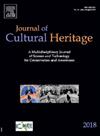Reviving the colors of paintings by removing the protective coating: a physical and virtual intervention
IF 3.3
2区 综合性期刊
0 ARCHAEOLOGY
引用次数: 0
Abstract
When an existing coating over a painting is detrimental to its reading and full appreciation, it needs to be removed. Coating removal to reveal the underlying painting, with minimal physical intervention, may provide additional information regarding the painting and guidance for its restoration or intervention.
A Neural Network (NN) was devised to simulate the removal of a painting’s coating, using as training data a small area of the painting where the coating had been physically removed. Simulations of coating removal using the NN and two additional methodologies were compared to actual physical removal.
Hyperspectral images of the paintings with and without coating were acquired, and chromatic variations were computed by estimating differences in just-noticeable different colors (JND) values and in the color gamut, using CIECAM16-UCS. Comparisons were made between paintings with and without coating, and between paintings without coating and their simulations.
Results showed that removing the coating led to an increase in JND values (1.8 times on average) and in the color gamut, but the magnitude was dependent on the initial condition of the coating. When simulating coating removal, the NN produced the best chromatic simulation, with an average JND of approximately 2.6 ± 0.5 (1.1 ± 0.2 excluding lightness), while other methodologies produced differences of approximately 8.6 ± 5.7 (3.7 ± 3.0 excluding lightness).
Results achieved with the NN highlight its capability for simulating coating removal with minimal physical intervention to the painting, a valuable tool when complete coating removal without outcome prediction would be undesirable.
通过去除保护层来恢复绘画的色彩:物理和虚拟的干预
当一幅画上现有的涂层不利于阅读和充分欣赏时,就需要将其去除。在最小的物理干预下,去除涂层以揭示潜在的绘画,可以提供关于绘画的额外信息,并为其修复或干预提供指导。设计了一个神经网络(NN)来模拟去除一幅画的涂层,使用油漆被物理去除的一小块区域作为训练数据。使用神经网络和另外两种方法模拟的涂层去除与实际物理去除进行了比较。使用CIECAM16-UCS获取涂有涂层和未涂有涂层的画作的高光谱图像,并通过估计刚刚可注意到的不同颜色(JND)值和色域的差异来计算颜色变化。比较了有涂层和没有涂层的绘画,以及没有涂层的绘画和它们的模拟。结果表明,去除涂层后,JND值和色域平均增加了1.8倍,但其幅度与涂层的初始状态有关。在模拟涂层去除时,神经网络产生了最好的色度模拟,平均JND约为2.6±0.5(1.1±0.2排除亮度),而其他方法产生的差异约为8.6±5.7(3.7±3.0排除亮度)。使用神经网络获得的结果突出了它在对绘画进行最小物理干预的情况下模拟涂层去除的能力,这是一个有价值的工具,当不希望完全去除涂层而不进行结果预测时。
本文章由计算机程序翻译,如有差异,请以英文原文为准。
求助全文
约1分钟内获得全文
求助全文
来源期刊

Journal of Cultural Heritage
综合性期刊-材料科学:综合
CiteScore
6.80
自引率
9.70%
发文量
166
审稿时长
52 days
期刊介绍:
The Journal of Cultural Heritage publishes original papers which comprise previously unpublished data and present innovative methods concerning all aspects of science and technology of cultural heritage as well as interpretation and theoretical issues related to preservation.
 求助内容:
求助内容: 应助结果提醒方式:
应助结果提醒方式:


